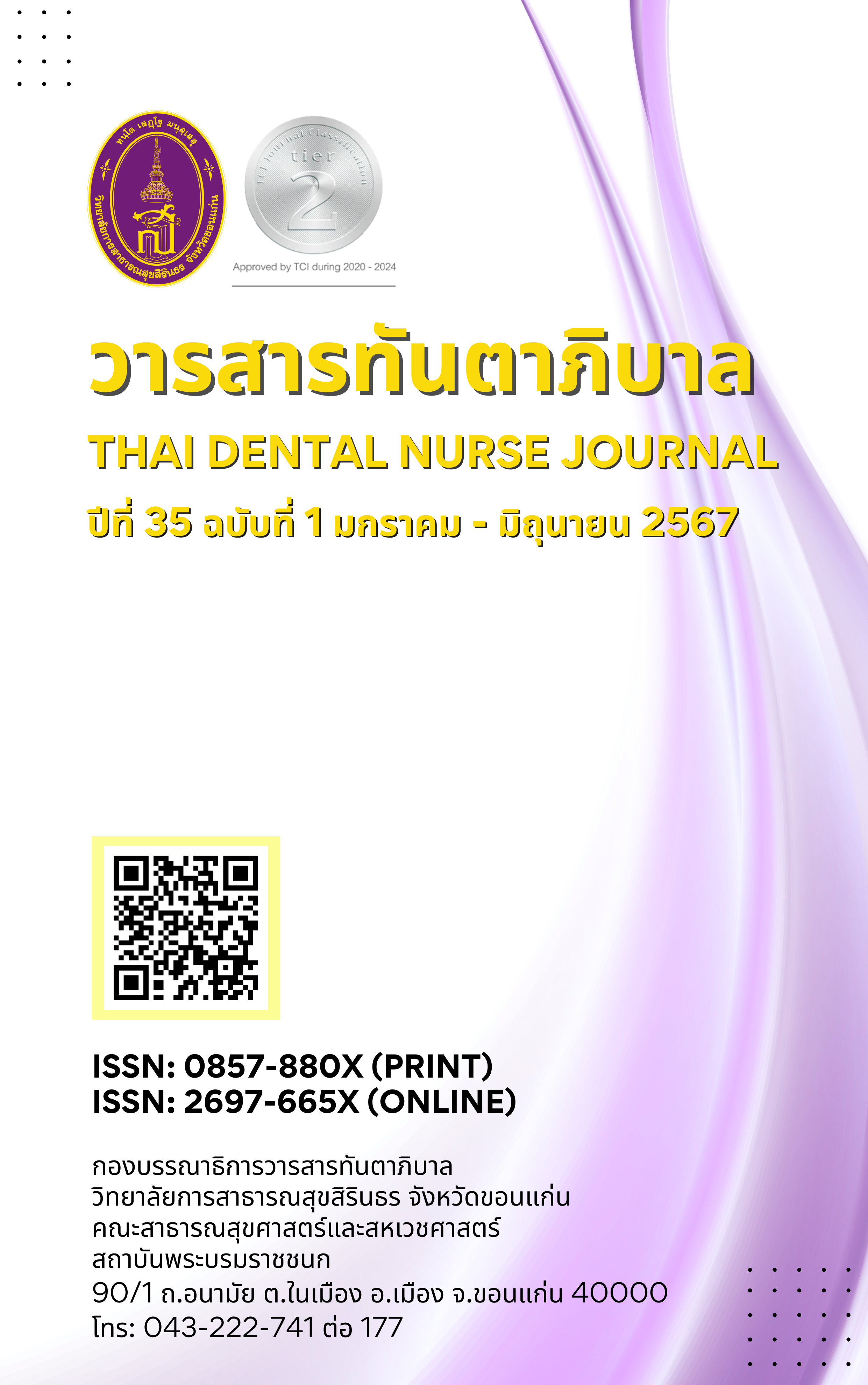The Accuracy of Analyzing Oral Lesions with Artificial Intelligence Devices
Keywords:
Artificial intelligence (AI), Oral screening, Precancerous lesion, Oral potentially malignancy disorders (OPMDs), Oral cancer, Differential diagnosisAbstract
Artificial intelligence is a tool to predict the probability of oral precancerous lesions. Photography techniques and the direction for importing photos should be used properly. The results of this research can be used as part of establishing a development program for community health worker (CHWs) to screen oral precancerous lesions and obtain the most accuracy in predicting lesions. This research was a cross-sectional descriptive study with the objective of comparing the accuracy in predicting lesions using different brightness of photos employing mobile light and natural light, the distance and direction of taking photos.
A purposive sampling was used to recruit the samples who came to visit at the dental department of Thalang Hospital, Phuket during October - December 2023. All samples who had oral precancerous or cancerous lesion were diagnosed by oral surgeon. The percent probability of precancerous lesions was analyzed by artificial intelligence technology.
The results showed that the medians of percent probability of oral precancerous lesions from 4 groups of techniques; 1) the natural light, non close-up group 2) the mobile flash light, non close-up group 3) the natural light, close up group and 4) the mobile flash light, close-up group were equal to 57.18, 63.35, 79.38, and 80.28 respectively. The medians of percent probability of all 4 groups were significantly difference (p-value <0.001), using Kruskal - Wallis test. Man-Whitney U test was used to identify the difference of pairs. For close-up flash light group, the percent probabilities of oral precancerous lesions with the different directions of photographs rotating 90, 180, 270 degrees from normal images while importing the data in artificial intelligence devices were significantly difference. (p-value = 0.037)
Conclusion close-up photography combined with mobile flash light from a mobile camera with a magnification power of more than 2 times showed the highest percent probability of oral precancerous lesion's prediction.
Percentage of artificial intelligence's probability of precancerous lesions in the oral cavity from horizontal direction (the normal photo group and the 180 degree rotation group) was higher than the vertical direction. (the 90 degree and the 270 degree rotation groups)
References
Bray F, Ferlay J, Laversanne M, Brewster DH, Gombe Mbalawa C, Kohler B, et al. Cancer Incidence in Five Continents: Inclusion criteria, highlights from Volume X and the global status of cancer registration. Int J Cancer. 2015; 137(9): 2060-71.
คณะกรรมการจัดทำแผนการป้องกันและควบคุมโรคมะเร็งแห่งชาติ กรมการแพทย์ กระทรวงสาธารณสุข. แผนการป้องกันและควบคุมโรคมะเร็งแห่งชาติ National Cancer Control Programme (พ.ศ. 2561 - 2565). นนทบุรี: กรมการแพทย์ กระทรวงสาธารณสุข; 2561.
Warnakulasuriya S. Causes of oral cancer--an appraisal of controversies. Br Dent J. 2009; 207(10): 471-75.
Ghantous Y, Abu Elnaaj I. [GLOBAL INCIDENCE AND RISK FACTORS OF ORAL CANCER]. Harefuah. 2017; 156(10): 645-49.
สถาบันมะเร็งแห่งชาติ กรมการแพทย์ กระทรวงสาธารณสุข. ทะเบียนมะเร็งระดับโรงพยาบาล. กรุงเทพฯ: สถาบันมะเร็งแห่งชาติ กรมการแพทย์ กระทรวงสาธารณสุข; 2564.
Sankaranarayanan R, Ramadas K, Thara S, Muwonge R, Thomas G, Anju G, et al. Long term effect of visual screening on oral cancer incidence and mortality in a randomized trial in Kerala, India. Oral Oncol. 2013; 49(4): 314-21.
Sankaranarayanan R, Ramadas K, Thomas G, Muwonge R, Thara S, Mathew B, Rajan B, et al. Effect of screening on oral cancer mortality in Kerala, India: a cluster-randomised controlled trial. Lancet. 2005; 365(9475): 1927-933.
มนัสวี ตันยะ. การตรวจประเมินรอยโรคก่อนมะเร็งและรอยโรคมะเร็งในช่องปากด้วยวิธีการเสริมแบบไม่รุกล้ำ. วารสารการแพทย์โรงพยาบาลอุดรธานี. 2564; 29(2): 304-13.
Warnakulasuriya S. Oral potentially malignant disorders: A comprehensive review on clinical aspects and management. Oral Oncol. 2020; 102: 104550.
Liu W, Wang YF, Zhou HW, Shi P, Zhou ZT, Tang GY. Malignant transformation of oral leukoplakia: a retrospective cohort study of 218 Chinese patients. BMC Cancer. 2010; 10: 685.
วสิศ ลิ้มประเสริฐ, กฤษสิทธิ์ วารินทร์ , ศิริวรรณ สืบนุการณ์. โครงการแพลตฟอร์มออนไลน์บนมือถือและปัญญาประดิษฐ์ แบบเรียนรู้เชิงลึกสําหรับการตรวจคัดกรองมะเร็งช่องปาก A Mobile Online Platform and Deep-Learning AI for Oral Cancer Screening. ปทุมธานี: มหาวิทยาลัยธรรมศาสตร์ ศูนย์รังสิต; 2566.
Haron N, Zain RB, Nabillah WM, Saleh A, Kallarakkal TG, Ramanathan A, et al. Mobile Phone Imaging in Low Resource Settings for Early Detection of Oral Cancer and Concordance with Clinical Oral Examination. Telemed J E Health. 2017; 23(3): 192-99.
Ilhan B, Guneri P, Wilder-Smith P. The contribution of artificial intelligence to reducing the diagnostic delay in oral cancer. Oral Oncol. 2021; 116: 105254. 14. Haron N, Zain RB, Ramanathan A, Abraham MT, Liew CS, Ng KG, et al. m-Health for Early Detection of Oral Cancer in Low- and Middle-Income Countries. Telemed J E Health. 2020; 26(3): 278-85.
Downloads
Published
Issue
Section
License
Copyright (c) 2024 Thai Dental Nurse Journal

This work is licensed under a Creative Commons Attribution-NonCommercial-NoDerivatives 4.0 International License.
บทความที่ได้รับการตีพิมพ์ถือเป็นลิขสิทธิ์ของวารสารทันตาภิบาล





